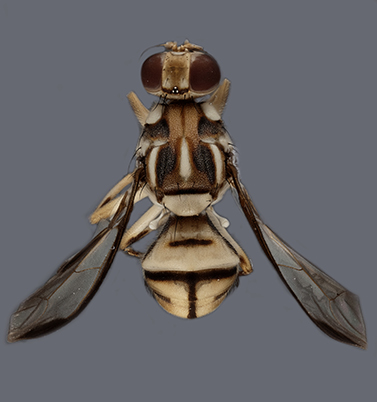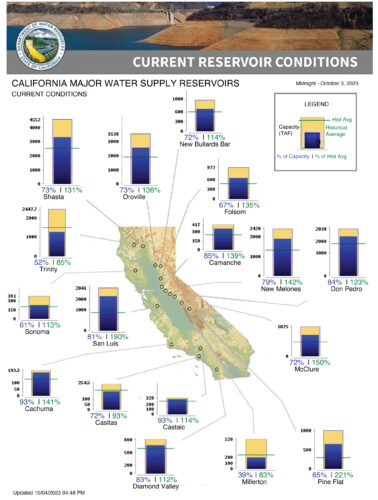Fruit Fly Fears and Tomato Triumphs: 2023 Crop Reflections
As the season approaches its final stretch, it is an opportune moment to reflect on what has been beneficial for the 2023 California tomato crop and what concerns we should carry forward into next year.
At the top of the list is the precipitation and snowfall that California received during the winter. Our reservoirs were replenished well above historical averages, and the rainfall played a vital role in leaching salts from the soils, which had accumulated during the previous drought years, particularly on lands irrigated with saline groundwater. This abundant water supply eased the pressure on groundwater pumping and allowed for the replenishment of water levels in some groundwater basins.
Currently, most reservoirs are significantly above historical averages (Figure A ), instilling optimism among farmers regarding the water supply for the 2024 season. Moreover, alongside the healthy carryover water supply in the reservoirs, some farmers were able to bank water for future use. Conditions are favoring an El Niño season through the spring of next year. El Niño, a warming of ocean surface temperatures in the equatorial Pacific Ocean, can have far-reaching effects on global weather patterns. While increased precipitation is typically associated with an El Niño year, California’s winter patterns are less predictable, and a robust El Niño is required to bring more storms. While this precipitation is beneficial for the water supply, it may lead to interruptions and delays in spring tillage and planting, similar to what we experienced in 2023.
The 2023 California tomato crop was fortunate to be spared from the curly top virus. Leafhopper counts, which are vectors for the disease, were significantly lower compared to previous years, as reported by the Beet Curly Top Virus Control (BCTVC) program. BCTVC had enhanced its scouting efforts after observing increased counts in both the northern and southern growing regions during the 2022 season.

FIGURE B | Photo by Severyn Korneyev
A new insect of concern is the fruit fly, with multiple species now detected in California. The Tau fruit fly (Figure B) was found in the Santa Clarita area, north of Los Angeles, and other species, including the Oriental fruit fly, have been discovered in various counties. The California Department of Food and Agriculture (CDFA) is closely monitoring these fruit flies to prevent their spread and is imposing quarantines as needed. There is a theory that the rise of E-Commerce may be linked to the spread of the fruit fly in California.
While dealing with the presence of fruit flies, the CDFA is also taking proactive measures to prevent the introduction of Tuta Absoluta, also known as the Tomato Leafminer. This destructive pest is well-established in Europe and other tomato-producing regions, and it appears only a matter of time until it is found in California. CDFA’s proactive stance is encouraging and offers optimism for the California tomato industry.
Morning Star continues to advance its tomato variety program and collaborates closely with tomato breeders. The goal is to develop high yielding varieties with disease and pest resistance for its growers, as well as varieties with optimal growing characteristics for greenhouse production. Additionally, the company focuses on processing characteristics that are efficient in both the factory and for ingredient customers. This feedback loop, spanning from seed to finished product, creates a platform for all parties associated with Morning Star to maximize their efficiencies.
###

Morning Star Newsletter now distributed electronically
As a reminder, Morning Star is now distributing our newsletters electronically using an email distribution vendor called Mailchimp. Your e-version will now include informative Morning Star videos and highlights. Depending on your company’s firewall, these emails may initially be directed to you spam folder.


